Army Vietnam War Northlake, IL Flight date: 06/19/24
By David Adams, Honor Flight Chicago Veteran Interview Volunteer
Sarge was on patrol in Vietnam walking point with his M-60 down a narrow trail. A tracer round whizzed, cracked, past him to his right. He immediately rotated his body to the left when a second round hit him in the chest exiting through his back just missing his lung. He fell to the ground face up, bleeding and playing possum while waiting for the ensuing fire fight to end. Charlie had popped out of a spider hole to target whoever was on point. The company medic treating his wound told him, “You have a million-dollar wound, Alf.” The “Dustoff” medevac chopper flew him to a MASH. He soon realized that he could go home as a result. “No way!” he said. “I want to go back with my guys. They’re a band of brothers, and you don’t leave your brothers behind.” Playing back the engagement in his mind he realized that if he had not turned away from the tracer, the second round would have killed him. He was awarded the Purple Heart.
Daniel M. “Sarge” Syniar was born in Chicago and grew up in Humboldt Park. In June 1966 he graduated from Tuley High School, located then on N. Claremont. He worked for Honeywell after graduation saving enough to buy a used red Chevrolet Stingray much to his parents’ chagrin. He remembers his dad always said: “Get a job, do your best.” The spring of 1967 saw the arrival of his draft notice and his induction into the Army in June.
He completed Basic and Advanced Infantry Training (AIT) at Fort Polk, LA. During the Vietnam War, Fort Polk was known as the “Home of the Combat Infantryman” due to the realistic basic and combat training taught there. During the eight weeks of AIT, Fort Polk had two training areas for up-and-coming infantrymen. Best known were Tiger Land and Tiger Ridge. Recruits would be immersed in field training involving patrol tactics, search and destroy missions, and attacking and even protecting the Vietnamese Village known as Tiger Village. Tiger Village was made up of many thatched huts, buildings, lookout tower, and animal pens. The tactics and training Sarge received at Tiger Ridge helped him survive when he arrived in beautiful exotic Vietnam. Due to the intensive training at Fort Polk soldiers arriving in-country to Vietnam did not have to go through a week of training with their new unit.
Upon completing training at Fort Polk, he got orders for the 90th Replacement Battalion, Long Binh Post, Vietnam. While waiting for his overseas flight in Oakland, CA, “my orders were changed and I was sent to Jungle Warfare School. This provided me with more training which probably saved my life.” That essential advanced jungle warfare training occurred at Schofield Barracks, HI known as the Jungle and Guerilla Warfare Training Center. Its goal was to train and prepare soldiers for deployments to jungle environments. Sarge’s training included land and compass navigation, water crossing, guerilla operations, anti-guerilla operations and ambush, first aid and hygiene, shelters and field craft, rope techniques, rappelling, and survival. He remembers that course lasted between four and five months.
Finally fully trained for infantry combat in Vietnam he flew directly to Chu Lai in the spring of 1968. Upon arrival at the airfield he was sent by chopper to Duc Pho where he dropped off most of his gear and went directly into the “boonies”. He became a member of the Americal Division, officially known as the 23rd Infantry Division, which was stationed primarily in the I Corps Tactical Zone in the northern part of South Vietnam. The Americal was based in the regions of Chu Lai and Da Nang.
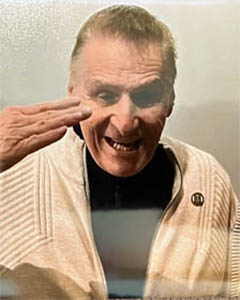
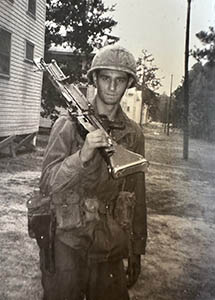
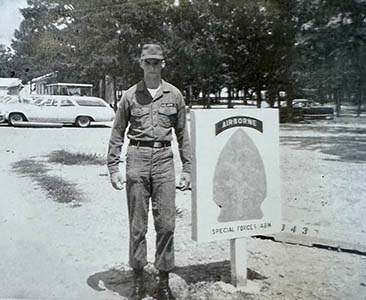
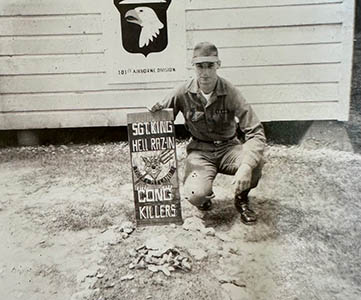
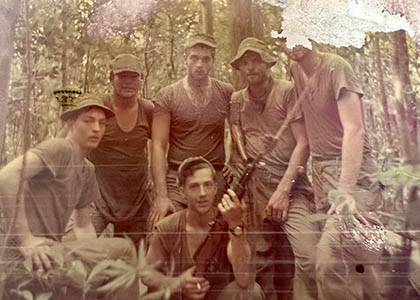

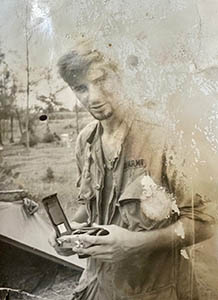
The first weapon he carried into combat was the M-60. Sarge remembers all the things he carried. Besides his principal weapon and plenty of ammunition for it he also “humped” four canteens of water and his 45 caliber sidearm with four clips of ammo. He retains vivid memories of his patrols, ambush operations, trail watch duties, dropping into LZs (landing zones) which could be (1) “hot” meaning immediate enemy engagement or (2) routine for commencement of a patrol or an operation. He learned fast. He recalls, “In Vietnam I was promoted to squad leader and at first carried a M-60 Machine Gun into many conflicts. As a Sergeant, I led groups of men through numerous battles.” Throughout his combat tour Sarge was dedicated “to serve and protect”. His advice to “newbies” was “don’t freeze in a fire fight”. His nickname was “Alf” and he remembers that everyone was given one as shorthand to be used instead of one’s real name.
Two particular battles haunt him.
The Division had discovered a North Vietnamese Army (NVA) “base camp” high up within a small mountain valley. Intelligence had revealed that it functioned as a way station/rest stop for infiltration of troops and supplies into the South. The camp consisted of a number of hootches with firing positions within as well as trenches for avoiding incoming fire from American and South Vietnamese fighters. He remembers his Lieutenant (LT) telling him to take most of the company, maybe 20-40 troops, into the vacant camp during the night and wait for the arrival of the NVA. It was pitch black under the jungle canopy. Eventually, he saw a long line of lights snaking down the mountain trail. The NVA were heading for their camp. His soldiers split into small groups and took up positions inside each hootch. His LT and he were in the first hootch toward which the NVA would approach. When several NVA soldiers entered the hootch the LT opened up with his weapon. As the fire fight began all the lights on the trail above went out. Sarge told his LT not to let the soldiers fire their weapons which would reveal their position. Use grenades instead. The fight lasted until dawn. In daylight they went back down the mountain. Reflecting on this battle he says that in the dark he had time to think about life and “I broke out my rosary”. Besides the NVA body count, what he remembers most were the “heat, flies, and leeches.”
Regrettably the world remembers the March 16,1968 My Lai Massacre and Lieutenant William Calley Jr’s involvement. That occurred in a Vietnamese village that the army designated My Lai 4 in Quang Ngai province. Many months later in August, 1968, the Division sent three choppers into an allegedly “abandoned” village complex in the same My Lai area. Sarge was in the third chopper to drop off its troops. The area was deemed to be unoccupied by NVA or Viet Cong forces. The troops jumped into knee deep rice paddy water. As soon as the third chopper deposited Sarge and others the NVA, their presence unknown to Army intelligence, began firing from bunkers surrounding the rice paddy. Thus began a three-day battle. Artillery support was called in along with close air support. Fighters dropped high drag bombs on the bunkers and other enemy positions. He marveled at the napalm detonations, especially at dusk. During the night flare ships kept the battlefield illuminated. Sarge survived but some troops were lost to friendly fire.
Sarge earned three Purple Hearts. The first is described above. On another patrol one of his men stepped on a Bouncing Betty mine which detonated and sprayed shrapnel over a wide area some of which hit Sarge in his right leg. “The Bouncing Betty is feared most. It is a common mine. It leaps out of its nest in the earth, and when it hits its apex, it explodes, reliable and deadly.” If I Die in a Combat Zone (O’Brien, 122). Another trip to the MASH! Purple Heart number two.
His final patrol: His platoon was on patrol moving along a dirt highway. Tank and/or armored personnel carrier tracks were apparent in the dirt. Stay out of the center of the road, walk on either side. However one of his men stepped on a mine, principally targeting tanks, tossing him into the air, causing severe wounds. The concussion/blast from the mine detonation threw Sarge onto his back, immobilizing him. Both he and the other injured soldier were medevacked to safety and treatment. Unfortunately the other man died in the chopper enroute. Sarge was in for an extended hospital stay and flight back to the States. Purple Heart number three.
Sarge was honorably discharged in April 1969 as an E-5, Sergeant . His awards and decorations include the Combat Infantryman Badge, Silver Star, Bronze Star, Purple Heart with two oak leaf clusters, Meritorious Unit Citation, National Defense Service ribbon, Army Good Conduct ribbon, Vietnam Service ribbon, and Republic of Vietnam Campaign ribbon.
When Sarge returned from the Vietnam War, he was not met with a hero’s welcome. He remembers being called a “baby killer”. He says he “wiped it out of my mind” for years and years. He was privileged to attend the dedication of The Three Servicemen Statue on the Mall in 1984. One of the soldiers carries an M-60.
Colleges solicited him to attend their schools, but he declined. Following his dad’s earlier advice, he went to work, taking a series of jobs first as a truck driver at UPS and later at a finance company. While working for UPS he met and married Therese on September 7, 1970. The effects of PTSD often prevented him from holding a steady job. With proper medical treatment from private health care sources he found a position at Data National as a project manager which he held for six years until 1996. The VA rates him 100% disabled although diagnosis and treatment for his PTSD took decades.
Reflecting on the times, he reports that in 1971 his younger brother received a very low draft lottery number, entered the Army, but did not deploy to Vietnam. “I am glad he didn’t have to go.” Regarding his own combat tour, “We’re just all proud of what we did, and we couldn’t show it, so all my life, I’ve held everything in.”
Nearly fifty years after his Vietnam combat service, in November 2017 the Chicago Blackhawks, WGN’s Marcus Leshock, and “Mr. Fix It” Lou Manfredini teamed up to honor Sarge and several other Vietnam War vets on United Center ice preceding a game. They were honored in front of thousands of cheering civilians. He said, “All us veterans that were there, they were cheering for all of us, and that just made my heart fabulous.” But there’s more! Manfredini had a special surprise. Because of his war injuries, Sarge struggles to do work around his home. Over the course of a few days, “Mr. Fix It” first surveyed the scene. He then repaired windows, patched up some holes, fixed a laundry room light, and gave the front door some new life with the help of the Blackhawks female ice crew members and Tommy Hawk, much to the delight of his grandchildren.
He and Therese, now married for 53 years, have two daughters and four grandchildren all of whom live very close to them, one right next door. Sarge will travel to DC with a buddy of his and looks forward to the special attention and honor to be bestowed on him and the other veterans.
Sarge, you have more than earned your Honor Flight to Washington, D.C. Enjoy every moment!


